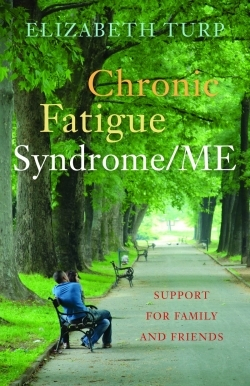Chronic Fatigue Syndrome/ME
Support for Family and Friends
Imagine having to climb six flights of stairs while seven months pregnant—with the flu and a temperature of 102 °F. Imagine going hungry because it’s too tiring to fix scrambled eggs or slice up an orange. Sufferers of chronic fatigue syndrome experience a fatigue so all-encompassing that even knocking the car’s brake lights out against a tree might not register until someone asks about the broken glass in the driveway.
Also known as myalgic encephalomyelitis (ME), chronic fatigue syndrome is a debilitating condition that as yet can only be treated symptomatically. Theories about causes abound, but the mystery surrounding it often leaves sufferers and those close to them frustrated, depressed, and angry. Symptoms include nausea, “shallow sleep” that is not restful, muscular soreness “on a constant or daily basis,” and pain that can feel as though it is lodged in the bones themselves. Palpitations, dizziness, anxiety, sensitivity to light and noise, painful lymph nodes, and a sore throat are also common symptoms that make diagnosis difficult. “Brain fog” makes it hard to concentrate and causes short-term memory loss that complicates problem-solving and even ordinary conversation.
First-time author Elizabeth Turp is no more able to suggest a cure for chronic fatigue/ME than anyone else, but her personal struggle with it infuses her sensitive guidebook with pragmatic suggestions for tackling the pervasive emotional and physical problems that the syndrome causes. The book’s five chapters delineate the disease and its effects in short sections that alternate with “How you can help” passages intended for the caregiver, co-worker, or friend.
Turp repeatedly emphasizes the embarrassment of suddenly becoming tired enough to need to sit on the floor or ground in a public place, and such candor about personal experiences helps caregivers understand how vital their willingness to deflect public stares and inquiries can be. “Pacing” activities by building in rest periods, matching one’s walking pace to that of the sick person, and avoiding loud or brightly lit venues are all examples of how caregivers can act as intermediaries for patients.
In addition to using this book, friends and family members may need to find support sources for themselves so they can better respond effectively to their loved one’s medical condition. Since chronic fatigue/ME can worsen unpredictably, both patients and caregivers struggle to manage its emotional ramifications and the strain it can put on relationships. Many patients fear being burdensome, or they may have trouble articulating their needs clearly, and many caregivers feel helpless when their loved one’s illness seems endless.
This book’s strength is its analysis of the difficulties people with chronic fatigue/ME experience when trying to work, maintain relationships, parent, or fulfill any of the multitudinous roles that comprise life. Its final chapter, “The Top Ten Tips on How You Can Help,” epitomizes Turp’s project. A “Resources” section provides an international listing of books, resources, agencies, and charities devoted to chronic fatigue/ME, all a very clear indication that those afflicted with this illness are not alone.
Reviewed by
Elizabeth Breau
Disclosure: This article is not an endorsement, but a review. The publisher of this book provided free copies of the book and paid a small fee to have their book reviewed by a professional reviewer. Foreword Reviews and Clarion Reviews make no guarantee that the publisher will receive a positive review. Foreword Magazine, Inc. is disclosing this in accordance with the Federal Trade Commission’s 16 CFR, Part 255.

